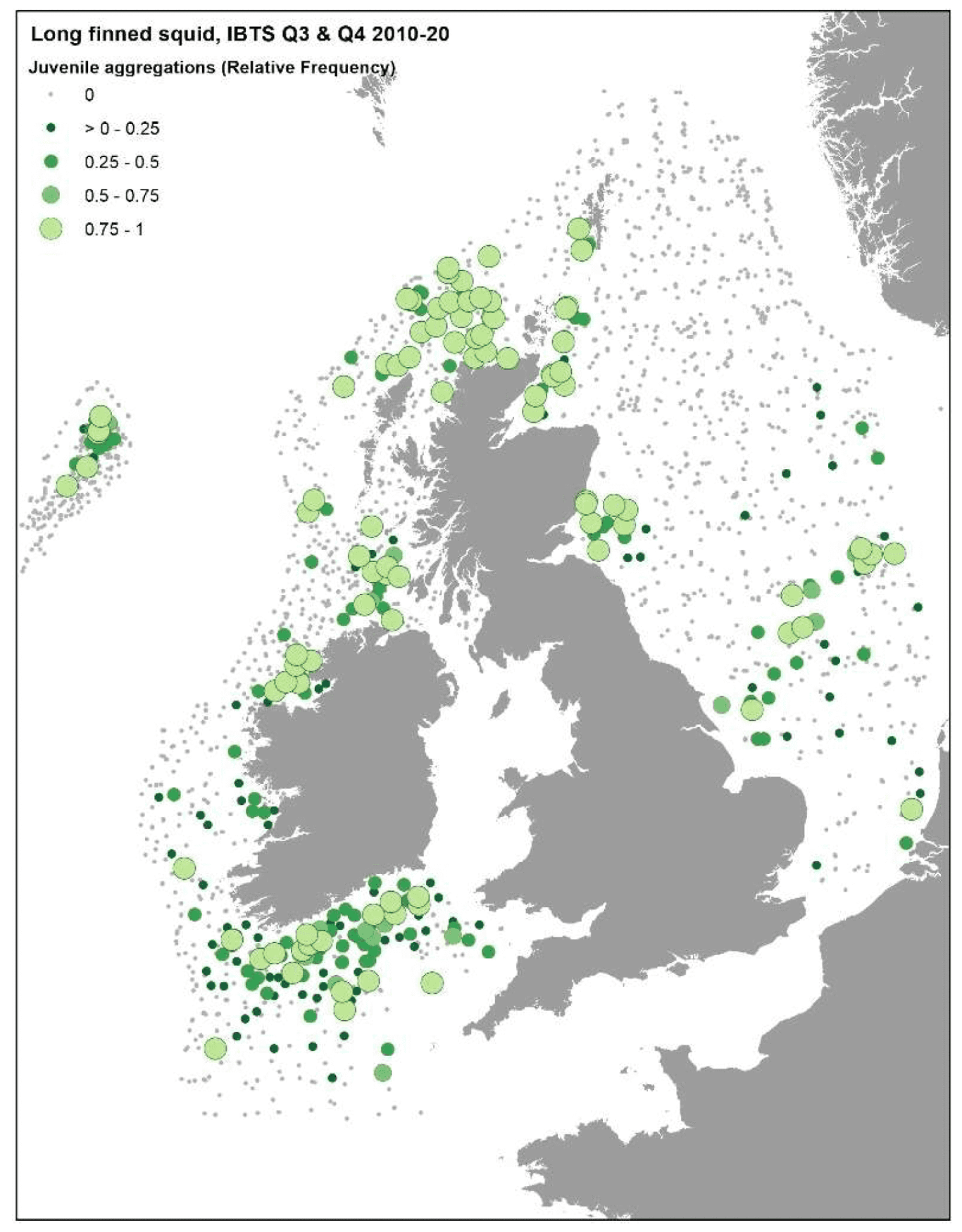Squid (Decapodiformes)
Key Findings
Introduction to Squid in Scotland
Squid play a vital role in marine food webs, acting as both predators and prey. As skilled hunters, they possess specialised adaptations that make them highly effective predators, influencing the populations of many marine species through their hunting strategies and diet. At the same time, squid are an essential prey for numerous marine animals, including salmon, cetaceans, whales and seabirds (Greenpeace, 2022). Several species of squid can be found in UK waters, inhabiting environments ranging from shallow coastal areas to deep oceanic waters. Species found in UK include; European common squid (Alloteuthis subulata), veined squid (Loligo forbesii), European squid (Loligo vulgaris), European flying squid (Todarodes sagittatus), Boreoatlantic armhook squid (Gonatus fabricii), common clubhook squid (Onychoteuthis banksii), large bobtail (Rossia macrosoma) and Atlantic bobtail (Sepiola atlantica) (Gov.uk, 2009). Of these listed, the veined squid (Loligo forbesii), and the European squid (Loligo vulgaris), are the two most common and commercially valuable in the UK (Cornwall Wildlife Trust, 2022).
Distribution
The veined squid (Loligo forbesii) is found in the waters of the Eastern Atlantic, from the Azores to the west coast of Africa, including the Canary Islands, and extending into the Mediterranean Sea and Red Sea. In contrast, the European squid (Loligo vulgaris) is also found in the Eastern Atlantic, ranging from the British Isles and the North Sea to the Mediterranean, and as far south as the coast of Africa (Wilson, 2008). In the UK, the veined squid is more abundant in northern regions, particularly in Scotland, while the European squid is more common in southern UK waters. Aggregations of juvenile veined squid throughout the uk can be seen in Figure 1.
IUCN classification and Population trends
Both the European Squid (Loligo vulgaris) and the Common Squid (Loligo forbesii) were both last assessed for The IUCN Red List of Threatened Species in 2015. Loligo vulgaris is listed as Data Deficient, indicating that there is insufficient information to determine its risk of extinction. In contrast, Loligo forbesii is classified as Least Concern, suggesting that it is currently considered to have a low risk of extinction (Allcock, A.L. & Headlam, J. 2019).
Threats to squid species and their future
Squid, like many marine species, face significant challenges driven by human activity, this includes: rising ocean temperatures linked to climate change, as well as ocean acidification and pollution. However, overfishing poses the greatest threat to their survival. In recent years, increasing demand for squid has driven a sharp rise in squid fishing vessels globally (McCallum & Das, 2022). While this trend is less evident around Scotland and the rest of the UK , growing demand and rising market value could soon lead to increased squid fishing in UK waters. Currently, cephalopods in Scotland lack welfare protections, and globally, there are no comprehensive regulations or monitoring systems for squid fishing (Gov.scot, 2021). This oversight allows jiggers to operate with minimal checks, with no controls on catch size or sustainability, creating a free-for-all in the industry (McCallum & Das, 2022). In Scotland, the landings of squid have been steadily increasing, after an initial spike in 2019. This can be seen in Figure 2. These figures do display a gradual increase- potentially driven by the drive in demand by foreign markets
Outlook for the species
The outlook for squid species in UK waters remains positive, as many are not currently considered threatened or endangered. However, the continued expansion of the squid fishing industry and growing demand from international markets could impact the sustainability of squid populations in UK waters. To safeguard these species, it is crucial to implement welfare protections and introduce regulations for jiggers, ensuring that squid fisheries operate both ethically and sustainably.

Fig. 1: (Eduardo Unda) - Dunnottar Castle

Figure 1. Juvenile aggregations of long finned squid (Loligo forbesi) taken from the west coast of Scotland demersal fish survey 2013/14.

Figure 2. Landings of squid species by Scottish vessels between 2019 and 2023, created by George Trantham using data from Scottish fisheries statistics.
Notes
None
Linked Information Sheets
Key sources of Information
Greenpeace UK. (2022). How squid fishing is harming our oceans
Offshore Energy SEA (2009). CEPHALOPODS
Cornwallgoodseafoodguide.org.uk. (2022). The Dark and Inky Art of Squid Fishing.
Greenpeace (2024). SQUIDS IN THE SPOTLIGHT: Unregulated squid fisheries are headed for disaster
SRLI, L.A. and Taite, M. (2015). IUCN Red List of Threatened Species: Loligo vulgaris.
The Scottish Government (2023). Developing essential fish habitat maps: report.
Reviewed on/by
Status
First Draft
To report errors, highlight new data, or discuss alternative interpretations, please complete the form below and we will aim to respond to you within 28 days
Contact us
Telephone: 07971149117
E-mail: ian.hay@stateofthecoast.scot
We need your consent to load the translations
We use a third-party service to translate the website content that may collect data about your activity. Please review the details in the privacy policy and accept the service to view the translations.

